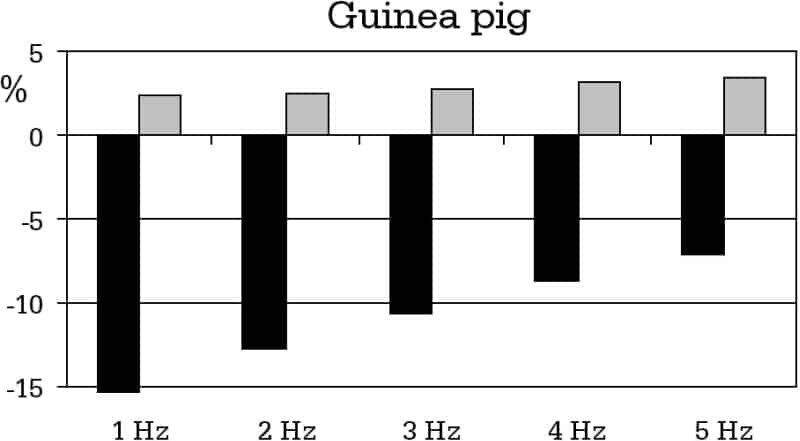The morphology of the cardiac transverse (t-) tubular system has been known for decades, but its function has received little attention. To explore the possible role of this system in the physiological modulation of electrical and contractile activity, we have developed mathematical models of guinea pig and rat ventricular cardiomyocytes in which the t-tubules are described as a single compartment (Pasek et al. 2003). The geometrical characteristics of the t-tubules, the biophysical characteristics of ion transporters, and their distribution between surface and t-tubular membranes in the models were based on available experimental data for the two species. Biophysically realistic values of mean access resistance to the tubular lumen and time constants for ion exchange with the bulk extracellular solution were included. The fraction of membrane in the t-tubules was set to 32% in the rat model (detubulation data of Brette and Orchard 2003) and to 52% in the guinea pig model (Amsellem et al. 1995). In both models, the action potential initiated by brief stimulation (1 ms, 1.5 x threshold) in current clamp is accompanied by transient K+ accumulation (Fig. 1, grey bars) and transient Ca2+ depletion (Fig. 1, black bars) in the t-tubule lumen. The amplitude of these changes relative to external ion concentrations was studied at steady state stimulation frequencies of 1 to 5 Hz. In the rat model (Fig. 1, rat), Ca2+ depletion increased from 11.8 % to 20.8 % with stimulation frequency, while K+ accumulation decreased from 4.3 % to 3 %. In contrast, the guinea pig model (Fig. 1, Guinea pig) exhibited a decrease of tubular Ca2+ depletion from 15.6 % to 7.1 % and increase of tubular K+ accumulation from 2.5 % to 3.4 % over the same frequency range. Thus, the relative Ca2+ depletion is 2-6 fold larger than K+ accumulation, and the frequency-related changes in t-tubular [Ca2+] and [K+] are in opposite directions in the two species. Therefore, these changes are likely to play an important role in the electrical and contractile responses to altered stimulation frequency in the two species.
University of Oxford (2004) J Physiol 561P, PC6
Communications: MODELLING CHANGES OF [Ca2+] AND [K+] IN THE T-TUBULES OF RAT AND GUINEA PIG VENTRICULAR MYOCYTES
Christe,Georges ; Pasek,Michal ; Simurda,Jiri ;
1. INSERM E0219, DRDC/DVE, CENG, F-32054, Grenoble, France. 2. Institute of Thermomechanics, Czech Academy of Science - branch Brno, 616 69, Brno, Czech Republic. 3. Department of Physiology, Faculty of Medicine, Masaryk University, 662 43, Brno, Czech Republic.
View other abstracts by:
Figure 1: Transient changes in tubular [Ca2+] and [K+] ions at various frequencies relative to external ionic concentration: rat ([Ca2+]e=1.2 mM [K+]e=5.4 mM) guinea pig ([Ca2+]e=1.8 mM [K+]e=5.4 mM). Note different vertical scales in the two panels.
Where applicable, experiments conform with Society ethical requirements.

![Figure 1: Transient changes in tubular [Ca2+] and [K+] ions at various frequencies relative to external ionic concentration: rat ([Ca2+]e=1.2 mM [K+]e=5.4 mM) guinea pig ([Ca2+]e=1.8 mM [K+]e=5.4 mM). Note different vertical scales in the two panels.](https://static.physoc.org/app/uploads/2019/01/22203914/PC6_A.jpg)
